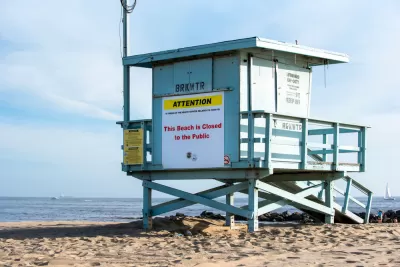Public health experts credit the controversial L.A. County public health order and the state's regional order, both of which banned outdoor dining, with reducing the viral spread that overwhelmed hospitals with COVID patients last month.

The Golden State no longer leads the nation in the seven-day average of new cases of COVID-19; that title goes to Texas, though California is a close second on Feb. 6. In per capita cases, the Golden State plummeted to #19 with 35 cases per 100,000 people, according to Covid Act Now on Feb. 7. South Carolina leads with 64 cases per 100k. The national average is 36 cases per 100k.
Conditions in California hospitals that were overwhelmed with COVID patients last month have improved dramatically, though intensive care unit (ICU) availability is still well below normal in much of the state. Public health experts told Rong-Gong Lin II and Soumya Karlamangla of the Los Angeles Times that the improvements "are the consequence of changes that Californians started to make two months ago."
The regional stay home order issued by the California Department of Public Health on Dec. 3, by far the strictest in the nation during the winter surge, is credited with keeping "as many as 25,000 people from landing in the hospital with a severe case of COVID-19," according to Lin and Karlamangla.
Scientists say that they can’t tease out which part of the order was most effective in turning the tide, but several leading public health experts interviewed by The Times agreed that the outdoor dining ban probably played a key role.
Los Angeles was the first county in the state, if not the nation, to ban outdoor dining in late November to reduce the spread of the coronavirus that was projected to severely impact hospitals. Restaurateurs sued successfully, but the ban was not lifted as it was replaced by Gov. Gavin Newsom's regional stay home order shortly before the state would soon become the epicenter of the pandemic in the U.S.
The ban on outdoor dining was not just to reduce the risk of transmission during dining but to keep people at home and reduce travel and household mixing. Cell phone mobility data show that it was effective.
In early December, Californians began moving around their communities at a rate 40% lower than what is typical — the lowest level since May — due to a combination of Newsom’s orders as well as a natural reaction to alarming case numbers and rhetoric from officials, said Ali Mokdad, an epidemiologist at the Institute for Health Metrics and Evaluation at the University of Washington.
[Mokdad informed NPR on Jan. 21 that the winter surge in the U.S. had peaked.]
Key metric: transmission rate
Measurements of the transmission or infection growth rate, referred to as R, dropped from 1.2 before the orders to 0.85 by early January. Below 1, the spread will slow, and grow when above 1.
In other words, within roughly two weeks of the new orders in late November, the county began to turn the corner. Because of the many weeks of lag time between new infections and hospitalizations, the effects of the stay-at-home orders would only become apparent a month later, in early January, when hospitalizations finally began to decline.
According to Covid Act Now, California has the nation's lowest infection growth rate, 0.75 on Feb. 7. Infections are slowing in the entire nation, though. Vermont leads with 0.98.
“You did the right thing at the right time,” Mokdad said. “The winter is working against all of us, but at least you preempted a much bigger surge of cases by doing what you did.”
Gov. Newsom lifted the regional stay home order on Jan. 25, and outdoor dining and indoor haircuts have resumed in the three regions where it had been banned due to ICU levels being below 15% availability. The ICU availability in the Southern California (9.1%) and San Joaquin Valley (10.7%) regions remained below the threshold as of Feb. 1, but the 4-week projection shows them will above it, according to the state Department of Public Health.
Counties have returned to operating under the COVID restrictions detailed in the state Health Department's Blueprint for a Safer Economy, with all but four rural counties operating under the strictest (purple) tier. While the infection trajectory is headed downward, the incidence of the disease is at far greater levels than it was at the height of the summer surge.
Notwithstanding the recent plunge in infections and the transmission rate and the promising news on the vaccine front, the worst may yet to come, according to many public health experts.
Another key but lagging metric
There is one coronavirus metric, sadly, which has yet to see significant improvement—the daily death toll, which averaged just under 500 on Feb. 5.
"California has tallied more than 43,000 deaths so far, with nearly 15,000 of those coming in January, and is on pace to surpass New York, which leads the nation with more than 44,000 deaths, within a week," writes Julia Prodis Sulek of the Bay Area News Group in a compelling piece about the Bay Area's "last responders" struggling to keep up with those who succumbed to COVID-19.
Related in Planetizen:
-
Outdoor Dining and Indoor Haircuts Return to California, January 27, 2021
-
California Hospitals Now Operating Under Contingency Care Guidelines, January 4, 2021
-
California's Hospital Crisis: What Lies Ahead, December 21, 2020
-
Another Grim Coronavirus Milestone: This Time in Southern California, August 19, 2020
FULL STORY: California’s outdoor dining ban was controversial. Did it help slow the COVID-19 surge?

Planetizen Federal Action Tracker
A weekly monitor of how Trump’s orders and actions are impacting planners and planning in America.

Chicago’s Ghost Rails
Just beneath the surface of the modern city lie the remnants of its expansive early 20th-century streetcar system.

San Antonio and Austin are Fusing Into one Massive Megaregion
The region spanning the two central Texas cities is growing fast, posing challenges for local infrastructure and water supplies.

Since Zion's Shuttles Went Electric “The Smog is Gone”
Visitors to Zion National Park can enjoy the canyon via the nation’s first fully electric park shuttle system.

Trump Distributing DOT Safety Funds at 1/10 Rate of Biden
Funds for Safe Streets and other transportation safety and equity programs are being held up by administrative reviews and conflicts with the Trump administration’s priorities.

German Cities Subsidize Taxis for Women Amid Wave of Violence
Free or low-cost taxi rides can help women navigate cities more safely, but critics say the programs don't address the root causes of violence against women.
Urban Design for Planners 1: Software Tools
This six-course series explores essential urban design concepts using open source software and equips planners with the tools they need to participate fully in the urban design process.
Planning for Universal Design
Learn the tools for implementing Universal Design in planning regulations.
planning NEXT
Appalachian Highlands Housing Partners
Mpact (founded as Rail~Volution)
City of Camden Redevelopment Agency
City of Astoria
City of Portland
City of Laramie





























